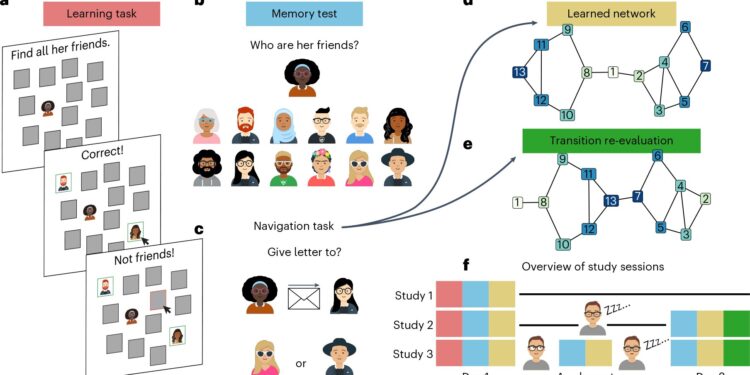Study design. Credit: Nature Human Behavior (2024). DOI: 10.1038/s41562-024-01990-w
How do people navigate social media to understand and appreciate who knows what and who is connected to whom? It’s done through mind maps, according to a new study led by researchers in the lab of Oriel FeldmanHall, associate professor of cognitive and psychological sciences at Brown University and affiliated with the university’s Robert J. and Nancy D. Carney Institute for Brain Sciences.
According to the researchers, the study showed for the first time that people create mental maps of connections between acquaintances, friends and friends of friends to navigate their social world. The team found that social navigation is similar to spatial navigation.
“The cognitive process people use to navigate social networks appears to be similar to the one mice use to navigate a maze,” FeldmanHall said. “We know from decades of research that both mice and humans construct mental maps to understand their physical world. People also appear to use maps to make sense of their social environment.”
The results were published in Nature Human Behavior.
To understand the mental mechanisms behind the development of social maps, the research team guided 146 Brown University students through a series of brief laboratory exercises.
In a computer flashcard game, study participants learned about the connections between 13 individuals in a network. They learned only about the connections between two people and never saw the entire network. They were then asked to choose the fastest way to get a message to a network member: to send it to person A or to person B?
Subjects were asked to perform the task immediately and after a night’s sleep. The researchers found that subjects performed higher when tested the next day, even when asked to route a message over longer distances spanning different communities within the network.
To understand what might be going on in the subjects’ minds, the team ran different computer learning models to characterize the mental maps the subjects were creating and to determine the role of a cognitive process called replay.
The replay method works as its name suggests, FeldmanHall explains. Over the course of a day, a person might learn that a coworker is friends with a cousin, and that cousin is friends with a classmate, who also knows the coworker. The researchers found that people use this knowledge to begin building, in real time, mental maps that help them learn, process and store information.
These mental maps can be true to reality, FeldmanHall explained, much as Google Maps mirrors the physical world of roads and transportation networks. The team found that at night, while they sleep, people explore these maps and revisit them through a replay-like mechanism.
“This discovery helps solve a long-standing puzzle in brain science,” said Jae-Young Son, lead author of the study and a postdoctoral researcher at the Carney Institute for Brain Science. “How do we navigate such a large and complex social world? This work shows that we create fuzzy mental maps of all the social connections that make up our network.”
“During sleep, our minds are busy simulating how information might flow from one person to another, as if we were mentally taking a stroll through the social network, which allows us to make better navigation decisions over longer distances.”
According to the researchers, their work suggests that during this process, the human brain reshapes maps, creating new possible social connections. People are not only replaying the relationships they know between the people they met that day, but they are also mapping out possible connections that these new acquaintances might have with other people they know.
By generating these new connections, mental maps are no longer faithful to reality, FeldmanHall explains. Instead, these “denser and fuzzier” maps appear to make navigating social networks easier, largely because they reduce the degrees of separation between people.
“Despite decades of active interest, we still know virtually nothing about the cognitive mechanisms that enable people to solve social navigation problems,” FeldmanHall said. “We filled this gap by drawing on a parallel line of research on spatial navigation in humans and rodents.”
More information:
Jae-Young Son et al, Replay shapes abstract cognitive maps for efficient social navigation, Nature Human Behavior (2024). DOI: 10.1038/s41562-024-01990-w
Provided by Brown University
Quote:Cognitive scientists reveal similarity between social and spatial navigation (2024, September 24) retrieved September 24, 2024 from
This document is subject to copyright. Apart from any fair dealing for the purpose of private study or research, no part may be reproduced without written permission. The content is provided for informational purposes only.



